Photographs: Reuters Gargi Gupta & Namrata Acharya in New Delhi
Rayabarapu Venu, 48, is an enterprising man. Around six months ago, the owner of Anjali Ladies Tailor and Fashion Design Institute in Mancherial, a bustling town in Andhra Pradesh's Adilabad district, bought three sewing machines and got into stitching curtains.
"Look at these," he says, proudly brandishing a pleated curtain, "No one stitches curtains like these here."
He also bought a mannequin to better display his wares, put up a smartly painted signboard at the entrance and bought some chairs for his 'fashion design' institute -- a tiny anteroom off the store's business area.
The money for all this -- Rs 45,000 -- came from two individual loans Venu took from Trident Microfinance.
Venu's life is transformed; his monthly income has gone up from Rs 3,000 around a year ago to between Rs 5,000-6,000 now.
. . .
Death now stalks India's microfinance institutions
Photographs: Reuters
Devayya, in Raikal, a small town an hour's drive from Karimnagar, has a very different story. The former two-wheeler mechanic is at home all day these days, lying on a mattress placed on the floor.
"I have diabetes," he says, pointing to the medicines and injections on the platform nearby. A pall of gloom shrouds the two-room tenement.
Devayya's wife Vattimal Bhagya committed suicide on July 25 this year, allegedly because she could not pay back the Rs 45,000 she had borrowed from microfinance institutions (MFIs).
"We took the first loan around two years ago to help my business," Devayya recounts. That was a Rs 10,000 loan from Spandana, a leading MFI in Andhra Pradesh.
When Devayya became ill a few months later, Vattimal took some more loans to meet medical and household expenses -- Rs 10,000 from SKS, Rs 10,000 from Trident, Rs 35,000 from Spandana.
. . .
Death now stalks India's microfinance institutions
Photographs: Reuters
When she defaulted on repayments, the four other members of her MFI group paid up, but when she defaulted again, they resented it.
"They came home and assaulted her," mumbles Sharanya, the eldest of Devayya's three children whose Rs 2,000 salary teaching at a nearby school is the only income the family now has.
The story of Shakina, a resident of Jagityal, also in Karimnagar district, is somewhat similar. The widow with two unemployed sons and a daughter committed suicide on July 14.
"Ammi had six loans -- two from Spandana, two from SKS, one each from Trident and Share -- amounting to around Rs 60,000," says Raisa, her daughter. At Rs 225 a week for each Rs 10,000 loan, Shakina's weekly repayments amounted to Rs 1,350.
Her income from stitching clothes -- the sewing machine was bought on a MFI loan -- nowhere near brought in that much.
. . .
Death now stalks India's microfinance institutions
Photographs: Reuters
Venu, Devayya, Shakina . . . as MFIs face the heat in Andhra Pradesh and elsewhere, accused of charging 'usurious interest rates' and using 'coercive means of recovery', the on-ground reality is a complex one.
Yes, in some cases MFIs have improved living conditions, but in many cases, they have also undone the already delicate balance in the lives of the poor.
Credit crunch
In the face of recent developments such as the October 15 Andhra Pradesh ordinance seeking to regulate the operation of MFIs, this debate has become an academic one.
Public opinion has turned sharply against MFIs, especially in recent weeks with politicians led by N Chandrababu Naidu jumping in to defend the debtors and telling them that they must not repay MFI loans, that if MFI officers come to their house asking for repayment they must lock them up and call the police -- all reported by the media in minute detail.
The result: "Collections in AP are down to nil in urban centres, and only 15-20 per cent in rural centres," says Kishore Puli, head of the Andhra Pradesh chapter of Microfinance Institutions Network (MFIN), a self-regulatory body of for-profit MFIs.
. . .
Death now stalks India's microfinance institutions
Photographs: Reuters
"The credit discipline that MFIs had built over the past 15 years is completely destroyed," he laments.
Worse, banks have stopped lending to MFIs, even against the sanctioned line of credit. Which is mystifying because it is banks that have bankrolled the MFIs' expansion thus far.
Public and private sector banks account for 78.5 per cent of MFIs' total borrowings of Rs 17,096 crore (Rs 170.96 billion); in addition, MFIs manage a loan portfolio of Rs 4,200 crore (Rs 42 billion) on behalf of banks.
Banks benefitted from this arrangement because lending to MFIs helped meet their priority sector lending targets.
"There had been a rise in securitisation deals between MFIs and banks last year," says K Natarajan, programme manager, Sa-dhan, the association of leading Indian MFIs.
. . .
Death now stalks India's microfinance institutions
Photographs: Uttam Ghosh/Rediff.com
In these transactions, a bank buys a pool of microfinance assets at a discounted rate, which then becomes part of the bank's books; the MFIs get upfront payment for the loans sold, and shares the interest charged from customers.
But all that's a thing of the past. "We have stopped lending to MFIs . . . and stepped up vigilance," says S L Bansal, executive director of the Kolkata-based United Bank of India.
MFIN head Vijay Mahajan, who is also founder-chairman of BASIX, a Hyderabad-based MFI, says he had talks with 33 bankers early this month but to no avail.
Three MFIs, including Share Microfin, one of the largest in the country, had sought a three-month moratorium on repayments and a restructuring of loans. Their plea was turned down.
P Mohannaiah, chief general manager of the National Bank for Agriculture and Rural Development in AP, says the government is open to proposals like debt restructuring, but coercive practices and high interest rates needed to go.
. . .
Death now stalks India's microfinance institutions
Photographs: Reuters
Point of interest
Interest rates are a sore point all around. "There was general antipathy to MFI interest rates, even amongst the clients," Mahajan acknowledges.
The problem is compounded by the fact that most MFI debtors are illiterate and many are even innumerate -- they can barely read, much less work out that the 12.5 per cent interest rate mentioned on their loan card works out to around 24 per cent on a reducing balance rate.
To add to that, the competition among MFIs in AP -- there are as many as 34 in the state which accounts for 23.4 per cent of all microfinance clients in India and 28.4 per cent of outstanding loans -- meant that they could easily get multiple loans.
RBI governor D Subbarao had indicated his displeasure at the high interest rates charged by MFIs as early as last December.
"Interest rate charges at 24-30 per cent seem too high. Compared to the informal sector, perhaps the rates are lower, but there are questions about whether these rates are affordable."
. . .
Death now stalks India's microfinance institutions
Photographs: Reuters
"Interest rate is one issue, but there are other factors as well, like multiple lending, over-indebtedness and coercive recovery," says U C Sarangi, chairman, Nabard.
"Ten years ago, the net return of MFIs was negative, margins were low and operating cost high. Today, it is the opposite. Return on assets is as high as 5 per cent, yield is as high as 40-43 per cent and expenditure has come down from 19-20 per cent to 11-12 per cent," he adds.
Sarangi has a point, given the large profits MFIs posted last year -- SKS: Rs 174 crore (Rs 1.74 billion); Spandana: Rs 203 crore (Rs 2.03 billion); and Share: Rs 109 crore (Rs 1.09 billion).
Most MFIs have responded to the charges by reducing interest rates to 24 per cent, from 26 per cent around a month ago.
. . .
Death now stalks India's microfinance institutions
Image: (Inset) Vikram Akula of SKS Microfinance.Photographs: Reuters
"We are also looking at measures like geographical distribution so that no more than two MFIs operate in one area, a grievance cell and restructuring of loans," says Udaia Kumar, managing director, Share Microfin.
But it may be too little too late.
Cash flows are running dangerously low, so MFIs are not disbursing fresh loans -- not just in AP but also elsewhere in India.
"We're giving fresh loans only in some of our new centres in Assam and Bihar," says Shubhankar Sengupta, managing director of Arohan, an MFI operating around Kolkata. And as Kumar points out, the reduction in disbursements is "pushing up operating costs".
In short, this is crisis time for MFIs, far worse than what they faced during the 'Krishna crisis' of 2006, when farmers' suicides resulted in a similar conflict with the state and MFIs had responded similarly by reducing interest rates.
. . .
Death now stalks India's microfinance institutions
Photographs: Reuters
In fact, it could be the end of the road for many of these for-profit MFIs, which constitute 80 per cent of the market and have been growing the fastest.
"If things continue this way, most of us will not be able to survive beyond the next two-three months," Puli says. Agrees Mahajan: "What you're seeing is the slow death of a sector."
If that happens, the ones to be hit hardest will be the poor debtors whose access to credit -- 'home delivered', as Venu says with pride -- will dry up.
Then they will have to choose between the uncertain mercies of government banks or the killer rates of money lenders.

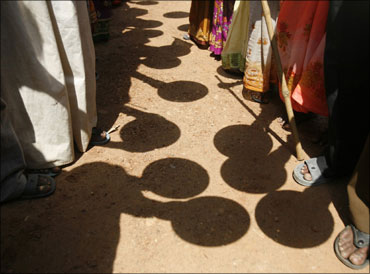
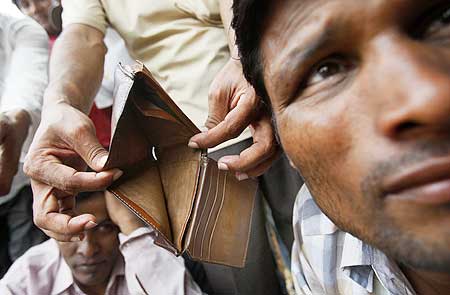
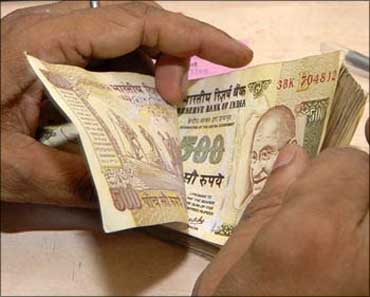
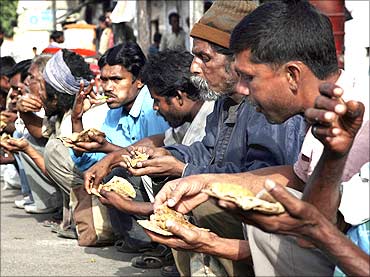
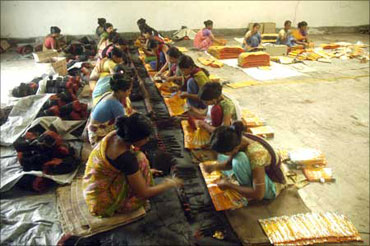

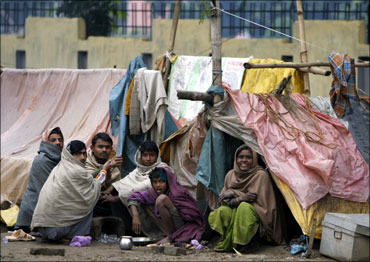




article